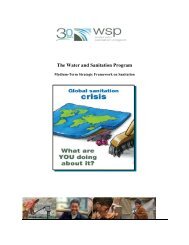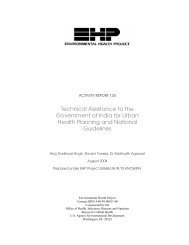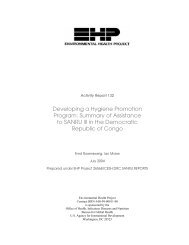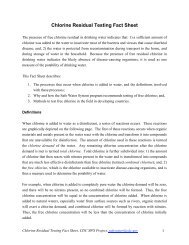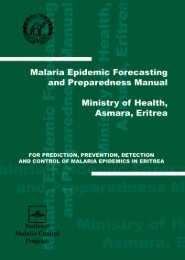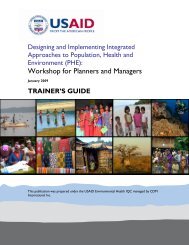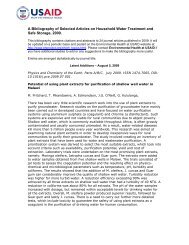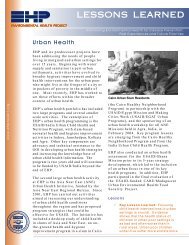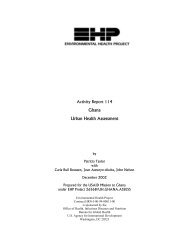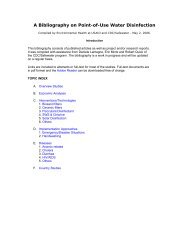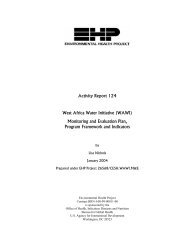Changing Glaciers and Hydrology in Asia - Environmental Health at ...
Changing Glaciers and Hydrology in Asia - Environmental Health at ...
Changing Glaciers and Hydrology in Asia - Environmental Health at ...
- No tags were found...
Create successful ePaper yourself
Turn your PDF publications into a flip-book with our unique Google optimized e-Paper software.
Demographic <strong>and</strong> socioeconomic factors, <strong>in</strong>clud<strong>in</strong>g the lack of reproductive health <strong>and</strong> familyplann<strong>in</strong>g services, <strong>in</strong>fluence people’s ability to cope with w<strong>at</strong>er stress, <strong>and</strong> the impacts of glaciermelt/retre<strong>at</strong> will exacerb<strong>at</strong>e these challenges. Effective governance is also crucial to a society’sresilience to n<strong>at</strong>ural <strong>and</strong> clim<strong>at</strong>e-change <strong>in</strong>duced disasters. Weak governance <strong>and</strong> barriers th<strong>at</strong>prevent people <strong>and</strong> communities from improv<strong>in</strong>g their lives, as well as <strong>in</strong>equalities of caste,ethnicity, religion, or tribes, all contribute to <strong>in</strong>creased vulnerability.These environmental <strong>and</strong> non-environmental factors <strong>and</strong> their <strong>in</strong>ter-rel<strong>at</strong>ionships necessit<strong>at</strong>e theuse of cross-sectoral <strong>and</strong> <strong>in</strong>tegr<strong>at</strong>ed approaches <strong>in</strong> the development of adapt<strong>at</strong>ion <strong>and</strong> mitig<strong>at</strong>ionstr<strong>at</strong>egies for glacier melt/retre<strong>at</strong> <strong>in</strong> <strong>Asia</strong>. Especially <strong>in</strong> High <strong>Asia</strong>’s small <strong>and</strong> remotecommunities, the <strong>in</strong>terrel<strong>at</strong>ed complex systems th<strong>at</strong> <strong>in</strong>clude ecosystems <strong>and</strong> human systems callfor <strong>in</strong>tegr<strong>at</strong>ed programm<strong>in</strong>g.USAID can use <strong>in</strong>tegr<strong>at</strong>ed programm<strong>in</strong>g models th<strong>at</strong> work cross-sectorally <strong>and</strong> through local<strong>in</strong>stitutions <strong>and</strong> communities to reduce vulnerability <strong>and</strong> strengthen resilience to the impacts ofglacier melt/retre<strong>at</strong> <strong>in</strong> High <strong>Asia</strong>. Good governance; social mobiliz<strong>at</strong>ion; <strong>and</strong> <strong>in</strong>form<strong>at</strong>ion,educ<strong>at</strong>ion <strong>and</strong> communic<strong>at</strong>ion (IEC) are cross-cutt<strong>in</strong>g themes; together with l<strong>and</strong>scape-levelplann<strong>in</strong>g, build<strong>in</strong>g on exist<strong>in</strong>g adaptive capacity, support<strong>in</strong>g low-cost adapt<strong>at</strong>ion, tapp<strong>in</strong>g exist<strong>in</strong>g<strong>in</strong>stitutional capacity, <strong>and</strong> mobiliz<strong>at</strong>ion across adm<strong>in</strong>istr<strong>at</strong>ive levels.At least two project models can be developed <strong>and</strong> tested to respond to the different hazards,risks <strong>and</strong> impacts; those associ<strong>at</strong>ed with glacier-hydrological regimes <strong>in</strong> more popul<strong>at</strong>ed, lowaltitude(5300 m) communities. These <strong>in</strong>clude loc<strong>at</strong>ions where low-altitude glaciers may be melt<strong>in</strong>g <strong>and</strong>pose direct thre<strong>at</strong>s to communities liv<strong>in</strong>g near the glacier term<strong>in</strong>us or alongside rivers, <strong>and</strong>loc<strong>at</strong>ions where GLOFs have occurred <strong>in</strong> the past or where advanc<strong>in</strong>g glaciers may impoundrivers <strong>in</strong> the near future <strong>and</strong> gener<strong>at</strong>e floods or debris flows. These thre<strong>at</strong>s affect humansettlements, l<strong>and</strong> <strong>and</strong> <strong>in</strong>frastructure beyond the exist<strong>in</strong>g glacier area. USAID’s OFDA is active <strong>in</strong>work<strong>in</strong>g on hydrometerological forecast<strong>in</strong>g <strong>in</strong> <strong>Asia</strong> <strong>and</strong> its experience is a resource for pursu<strong>in</strong>gthese issues.Sectors AddressedHuman reproductive health <strong>and</strong> family plann<strong>in</strong>g, w<strong>at</strong>er resource management, biodiversity <strong>and</strong>ecosystems conserv<strong>at</strong>ion, agriculture, energy, health, <strong>and</strong> disaster preparedness/management.Illustr<strong>at</strong>ive ProgramsIllustr<strong>at</strong>ive programs focused on high-mounta<strong>in</strong> communities <strong>in</strong>clude the follow<strong>in</strong>g:1. At the n<strong>at</strong>ional level, programs could support the development plann<strong>in</strong>g processes th<strong>at</strong>promote community-based <strong>and</strong> <strong>in</strong>tegr<strong>at</strong>ed approaches to glacier disaster preparedness <strong>and</strong>risk reduction th<strong>at</strong> are comprehensive <strong>and</strong> <strong>in</strong>clude family plann<strong>in</strong>g <strong>and</strong> susta<strong>in</strong>ablemanagement of w<strong>at</strong>er resources among other cop<strong>in</strong>g <strong>and</strong> adapt<strong>at</strong>ion str<strong>at</strong>egies. Theprograms should seek to ma<strong>in</strong>stream <strong>in</strong>tegr<strong>at</strong>ed approaches <strong>in</strong>to exist<strong>in</strong>g policies <strong>and</strong> actionplans (i.e., NAPAs for the UNFCCC) r<strong>at</strong>her than cre<strong>at</strong>e new <strong>in</strong>iti<strong>at</strong>ives.65



